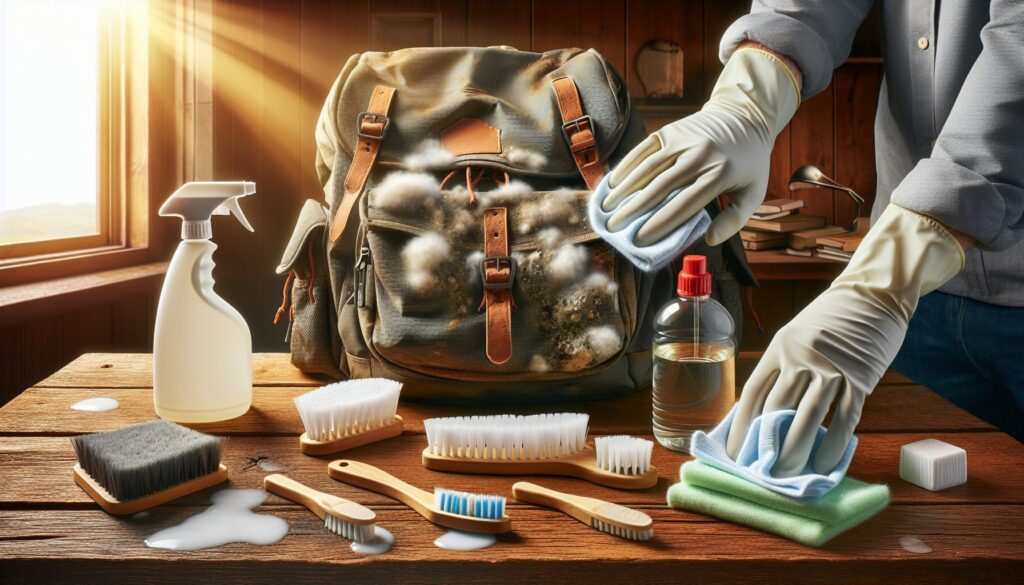Are you grappling with a moldy hiking backpack? Fear not! We’re here to help you with expert techniques to banish mold and keep your backpack fresh and clean. Let’s get started!
First, let’s delve into what causes mold growth in hiking backpacks and how to spot it. Then, we’ll guide you through the process of eliminating mold and preventing future growth. Ready to embark on this journey? Let’s go!
Table of Contents
Decoding Mold Growth in Hiking Backpacks
| Triggers of Mold Growth in Hiking Backpacks |
|---|
| High humidity and moisture levels during hikes |
| Inadequate storage and ventilation |
| Dirty or damp clothes and gear |
Mold growth in hiking backpacks is primarily triggered by high humidity and moisture levels during hikes. When you’re backpacking in humid environments, the trapped moisture inside the backpack can create a perfect breeding ground for mold. Inadequate storage and ventilation can also contribute to mold formation. For instance, storing a backpack in a closed, damp environment or not allowing it to dry completely after use can lead to mold growth. Additionally, dirty or damp clothes and gear packed inside the backpack can introduce moisture and promote mold growth. Therefore, it’s crucial to clean and disinfect your backpack thoroughly using appropriate cleaning agents and take preventive measures to minimize the risk of mold growth.
The Health Hazards and Risks of Mold in Hiking Backpacks
Mold growth in hiking backpacks can pose serious health hazards. Exposure to mold spores can lead to respiratory issues, such as coughing, wheezing, and allergic rhinitis. In some cases, it may also trigger asthma attacks. Moreover, mold can cause an unpleasant odor and deterioration of the backpack material, affecting its durability and lifespan.
Furthermore, the presence of mold in backpacks can potentially damage electronics and other items stored inside. Mold spores can penetrate electronic devices, causing them to malfunction. The accompanying moisture can also harm items such as clothes, sleeping bags, and food supplies. Therefore, it’s crucial to take immediate action to remove mold from hiking backpacks to safeguard both your health and the integrity of your equipment.
Step 1: Spotting Mold in Your Backpack
One of the first signs of mold in your hiking backpack is visible mold growth. Inspect the entire surface of your backpack, paying close attention to any areas that may have been exposed to moisture. Look for black, green, or white patches that appear fuzzy or slimy. If you spot any mold, take immediate action to prevent further damage.
Another indication of mold is a musty smell. Mold can produce a distinct odor that is often described as earthy or damp. If you notice an unpleasant smell emanating from your backpack, it’s a good idea to investigate further for mold contamination.
Step 2: Eradicating Mold from Your Hiking Backpack
Now that you’ve identified the presence of mold in your backpack, it’s time to eliminate it. Here’s a step-by-step guide to help you effectively remove mold and extend the life of your hiking backpack. Remember, regular cleaning and drying of your backpack can prevent the development of mold spores.
Assemble necessary supplies and materials:
– Before you begin removing mold from your hiking backpack, ensure you have all the necessary supplies and materials. This includes:
– White vinegar or hydrogen peroxide: Both are effective natural mold killers.
– Baking soda or borax: These substances help deodorize and remove any lingering mold smell.
– Soft-bristled brush: Choose a brush that won’t damage the material of your backpack.
– Clean cloth or sponge: Use these to apply cleaning solutions.
– Warm water: Dilute the cleaning solution and rinse your backpack.
– Plastic sheet or tarp: Lay this down to protect your work surface.
Cleaning techniques for different backpack materials:
Synthetic backpacks:
– Fill a basin or sink with warm water.
– Add a quarter cup of vinegar or hydrogen peroxide.
– Submerge the backpack in the solution and let it soak for about 15 minutes.
– Use a soft-bristled brush to gently scrub away the mold.
– Rinse the backpack thoroughly with warm water and let it air dry.
Canvas or nylon backpacks:
– Mix warm water and a tablespoon of mild detergent.
– Dampen a clean cloth or sponge with the solution and gently scrub the moldy areas.
- Rinse the cloth or sponge frequently and continue until the mold is removed.
– Rinse the backpack thoroughly with warm water and let it air dry.
Leather backpacks:
– Brush off any loose mold with a soft-bristled brush.
– Mix equal parts water and vinegar in a spray bottle.
– Mist the affected areas, ensuring they are damp but not soaked.
– Gently wipe away the mold using a clean cloth.
– Allow the backpack to air dry and then condition the leather as recommended.
Remember to test the cleaning solution on a small, inconspicuous area before applying it to the entire backpack. Ensure your backpack is completely dry before storing it to prevent mold from returning.
Step 3: Treating Mold-infested Items in Your Backpack
Mold infestation can be a common issue when it comes to hiking backpacks. Properly cleaning and disinfecting clothes and gear is crucial to get rid of mold and prevent its spread. When dealing with shoes and boots, make sure to remove any visible mold by scrubbing them with a brush and a mixture of water and mild detergent. Afterward, thoroughly rinse and dry them before storing. Electronics and sensitive items should be handled with care. Wipe them down with a cloth dampened with mild detergent and water solution, ensuring that no liquid enters any openings. Allow them to air dry completely before use. By following these steps, you can effectively treat mold-infested items in your backpack and ensure a clean and safe outdoor experience.
Step 4: Preventing Future Mold Growth in Your Hiking Backpack
After removing mold from your hiking backpack, it’s crucial to take preventive measures to avoid future mold growth. Thoroughly drying your backpack after each use is essential. Make sure to hang it out in a well-ventilated area until completely dry. This will help prevent any moisture from lingering and creating a suitable environment for mold to thrive.
In addition to proper drying, effective storage and ventilation strategies play a significant role in mold prevention. When storing your backpack at home, choose a cool, dry place away from direct sunlight. Keep it elevated off the ground to allow air circulation. During hikes, consider using a waterproof cover or a dry bag to shield your backpack from rain or any other sources of moisture.
Airing out your backpack during breaks can also help prevent mold growth. Take advantage of breaks to remove the contents from your backpack and allow it to breathe. If possible, find a sunny spot or a well-ventilated area to air it out for a short period.
| Thoroughly drying your backpack after each use |
|---|
| Hang the backpack in a well-ventilated area until completely dry. |
| Effective storage and ventilation strategies |
|---|
| Store the backpack in a cool, dry place at home, away from direct sunlight. |
| Elevate the backpack off the ground to allow air circulation. |
| Guidelines for storing your backpack at home |
|---|
| Choose a cool, dry place away from direct sunlight. |
| Keep the backpack elevated off the ground. |
| Guidelines for storing your backpack during hikes |
|---|
| Consider using a waterproof cover or a dry bag. |
| Suggestions for airing out your backpack during breaks |
|---|
| Remove the contents and find a sunny spot or a well-ventilated area to air it out. |
Tip 1: Opting for Mold-resistant Backpacks and Gear
Choosing the right hiking backpack that is mold-resistant is an important step in keeping your gear clean and preventing mold growth. Look for backpacks made from materials such as polyester, nylon, or Cordura, as these materials have natural resistance to mold. Avoid backpacks made from cotton or canvas, as they tend to retain moisture and are more prone to mold growth.
In addition to choosing the right backpack material, it’s also important to select clothing and accessories that are quick-drying. Quick-dry materials, such as synthetic fabrics, wick away moisture and prevent it from being trapped in your backpack. This reduces the risk of mold growth and keeps your gear fresh and odor-free.
By following these tips and selecting mold-resistant backpacks and gear, you can enjoy your hiking adventures without worrying about mold growth and the unpleasant odors that come with it.
Tip 2: Packing and Organizing Your Backpack to Prevent Mold
Properly arranging your clothes and gear in your hiking backpack is key to preventing mold. Ventilation is crucial, so make sure to avoid tightly packing your items. Allow space between your belongings, allowing air to circulate and prevent moisture buildup. One helpful tip is to utilize dry sacks or plastic bags for any wet items, such as rain gear or a damp towel. These waterproof containers will prevent moisture from spreading to other items in your backpack. Additionally, consider using fabric or mesh organizers to further promote airflow and ventilation. Separate your used or dirty clothes from the rest of your gear, keeping them in a separate bag to avoid mold growth. Remember to wipe down your backpack after each use to remove any moisture or dirt that could contribute to mold growth. By following these steps, you’ll be well on your way to keeping your hiking backpack mold-free!
Tip 3: Establishing a Cleaning and Maintenance Routine for a Mold-free Backpack
To keep your hiking backpack mold-free, it’s important to establish a regular cleaning and maintenance routine. This will help prevent the growth of mold and mildew, ensuring that your backpack remains fresh and clean for your outdoor adventures.














